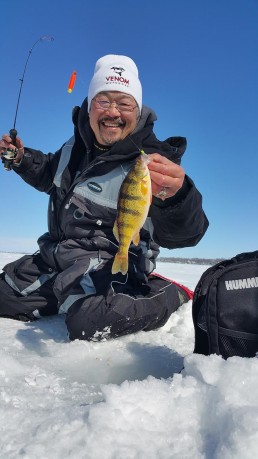Use Today’s Tools for Big-time Ice Fishing Success
SHARE THIS POST

With the rapidly changing times of the digital age, advancements in ice fishing technology has changed the face of our beloved sport. Let’s use this technology to our advantage to catch more fish!
The very first ice fishing pioneers often used a “jiggle stick,” which was nothing more than a stick with a nail on the tip that held fishing line. Rod manufacturers now build shorter, highly sensitive graphite rods that hold spinning reels, so anglers can reel fish in just like they were in a boat.
The modern ice angler wears high-tech, waterproof, breathable clothing to keep warm. In addition, new space age heaters are small and portable enough for modern day fish houses.
Ice fishing took a giant leap forward with the invention of portable ice shacks made of lightweight, durable material. Anglers transformed into hunters who easily could move from area to area to find fish.
Fish became even easier to find when open-water electronics were adapted to hard-water use. For example, early “flashers” were helping boat-bound anglers find structure to locate fi sh. It wasn’t long before these same electronics teamed up with small motorcycle batteries and became portable.
Ultra-responsive LCD screens now handle cold weather and are show fish whether they’re tight to the bottom or just below your hole. Electronics help you determine the fish’s mood by seeing how they react to your jigging action. This allows you to adjust how you work your lure until you find something that triggers a strike.
Are you enjoying this post?
You can be among the first to get the latest info on where to go, what to use and how to use it!
Today, even more advanced sonar units, such as Humminbird’s Ice Helix 7, combine with GPS and lake mapping systems to help anglers quickly dissect big lakes and find success.
Searching for fish through the ice begins with the understanding that fish need to find food now, just like they do in open water. When the ice first forms on natural lakes, ice experts look for shallow water weedbeds. Productive weeds can be found 6 to 10 feet down in darker lakes and deeper in clearer water.
For walleye fishing, spoons are go-to lures. Snap-jig them and then quiver, lift, and quiver again. Try tipping the spoon with a minnow head. A small 1/32-ounce jig tipped with a eurolarvae is perfect for panfish.
Mid-lake humps often hold walleyes. The search for structure often took hours in the old days. Now, GPS can take ice fishermen right to them as the weed beds decay and the fish move out.
To further your ice fishing knowledge, look for Ted’s full article in the January issue of MidWest Outdoors magazine, available now on the newsstand or by subscribing on the MidWest Outdoors website.
MWO
SHARE THIS POST
You may also like...
Nothing found.
Did you enjoy this post?
You can be among the first to get the latest info on where to go, what to use and how to use it!
